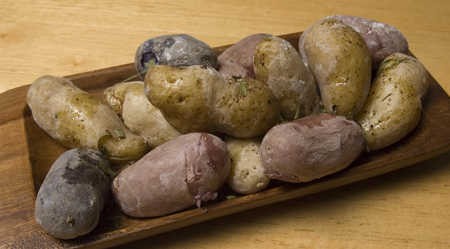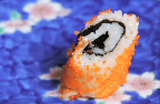 Call me “radical” ‘diplomatic” “bi-polar” or even just plain “odd,” but I love the alternative perspective. The concept that the ideas and things that I accept as a truth (or rather, the habit of truth) might have another viewpoint worth listening to, I feel is not only a healthy one, but fascinating. Whether it’s inside looking out, or outside looking in, the ability to be flexible and accepting of perspective is the font of knowledge and growth of thought. Of course, that’s when it applies to thought. In action, however, I tend to be more of a “Think before you leap” kinda guy. I have this crazy idea that if we just thought about the foods we eat, before actually eating them, it might help curtail our dietary excesses, and that possibly seeing what we eat through another viewpoint might help us stop and think, before consuming.
Call me “radical” ‘diplomatic” “bi-polar” or even just plain “odd,” but I love the alternative perspective. The concept that the ideas and things that I accept as a truth (or rather, the habit of truth) might have another viewpoint worth listening to, I feel is not only a healthy one, but fascinating. Whether it’s inside looking out, or outside looking in, the ability to be flexible and accepting of perspective is the font of knowledge and growth of thought. Of course, that’s when it applies to thought. In action, however, I tend to be more of a “Think before you leap” kinda guy. I have this crazy idea that if we just thought about the foods we eat, before actually eating them, it might help curtail our dietary excesses, and that possibly seeing what we eat through another viewpoint might help us stop and think, before consuming.
Outside Looking In: No Chocolate-mint for Japanese Students
Two years ago I was helping Yoshio teach his classes at the Showa Institute. Yoshio does this really clever thing by teaching American culture through our foods. He covers all the sundry styles of our cooking, and the Japanese students pick up a lot about American history and cultures through his class. Yoshio was taking a group of them around one of supermarkets, which was entertaining in itself, as the large grocery stores we have in America don’t exist in Japan. The group of students were hovering around the cookie aisle, and I boldly recommended my favorite cookie, the Pepperidge Farm Mint Milano. After Yoshio translated my enthusiastic praising, I was disappointed to have the students (every single one of them) pass on the Milanos as they bought other cookies. Later, I asked Yoshio why and he replied that Japanese detest the chocolate-mint combination. “Buuuut….why?” was my incredulous response. Yoshio thought for a moment and said “To them, it’s a little like brushing your teeth with a mint toothpaste and then reaching for a chocolate bar.” I’ll never stop loving the chocolate/mint taste mixture, but it’s fascinating that pretty much an entire culture cannot even fathom it!
Inside Looking Out: No Vegemite for American Rodents
A number of years ago I had an exchange student from Australia. Emma was a bit of card, and through her I got a good representative of the outrageous Australian humor, which entailed a lot of “taking the piss out” or as we say, “yanking the chain” of her hosting Yanks. Emma decided she would introduce us to that uniquely Australian “delicacy,” vegemite. Made of brewer’s yeast, salt, and mashed into a brown paste, Australians generally put vegemite on toast with a little butter as a breakfast food. When she passed it out to us all, I kinda got that Emma was going to enjoy our reactions to vegemite a little too much, so after a bite, I told her, “Well, it’s definitely an acquired taste!” Inside I was screaming, “OMG, that is the most VILE thing I have ever tasted. It tastes like what the bottom of a garbage can smells like!” Emma said that perhaps I had applied a little too much on my cracker. All I know, is that we had a mouse harboring itself in our basement that winter. The last person trying the vegemite, on Friday, left out the crackers with the vegemite. When I came in the next Monday, despite the temptation of tasty, unguarded crackers, the mouse came nowhere near! I was convinced it was the smell of the vegemite that drove him away.
The Tongue of the Beholder:
I was telling the vegemite story to my friend Miquel recently and he replied “Well, you like cheese don’t you?” The Chinese think that cheese is just disgusting! Think of how they must see what cheese actually is!” I thought to myself, “Oh, right: curdled, congealed bovine milk.” I once had a friend who hated tomatoes. “How could anyone hate tomatoes!” I asked. “Really, what is there to like?” my friend replied. “Seedy, watery bags with a semi-solid, pudding-like skin on the outside, with almost no flavor.” I still enjoy tomatoes (particularly fresh from the garden) so this perspective doesn’t stop my liking of tomatoes, but I do think about my friend’s opinion every time I cut into a tomato. Talking to my sister recently about a tofu-based dish I had created, her instantaneous reply was “Tofu….oh, yuck!” I didn’t pursue this as I could easily see tofu from her perspective as a flavorless, watery, protein sponge. If I had pursued it, I could have said that a mark of a good chef is a someone who can make even tofu taste good!
So that got me thinking about foods Americans eat and don’t ever consider how an objective eye might look at them. I’ve already done Fluff, so I’ll leave that off the list, but here’s a few others:
“American Cheese”: Essentially, make a facsimile of a slice of cheese. Mix milk, whey, sundry protein concentrates. Remove most nutrients. Add yellow #6 to put in some color that resembles cheese. Liquefy to make a pourable product. Add aerosol to spray it. Legally cannot be called “cheese” as there is no actual cheese present. As an aside, the term “whiz” should never, ever be paired with food. Just saying.
Pickles: Take a perfectly good small cucumber and boil just enough to remove most nutrients. Bottle in a salty vinegar with spices. To fully negate any of remaining nutrients left, add sugar.
Jell-O: Take the bones and hides of various animals and boil them down. Remove water. Grind to a powder and add sugar and food coloring the shade of neon.
White Bread: Grind wheat down and remove the healthy fiber and any nutritional part. Bleach. Add yeast, water, salt and a little sugar. Pump artificial nutrients in to replace the ones you originally took out. Bake.
“Cheeze-Balls”: Take corn and make into a mush. Blow air into the mush and bake into perfectly identical marble-shaped spheres. Coat with an iridescent cheese-flavored powder the exact color and luminosity of certain glow-sticks.
Smores: Take a sugary cracker, add a block of chocolate, top with more sugar (in the form of a marshmallow) and top with another sugary cracker. Toast over an open flame. Have Bactine handy for the singed digits from flames and drips of molten chocolate and sugar.
“Buffalo” Wings: Cut wings from chicken, keep fatty skin attached. Add more fat by frying wings in oil. Add even more fat with a butter and pepper sauce so hot that it makes the eater sweat, wince, and eyes water.
“Salad Dressing”: Make a facsimile of mayonnaise, lowering the fat content by reducing egg yolks and add more sugar. Have endless debates with the mayonnaise crowd about the relative “values” of two fatty, largely tasteless condiments.
“Crab Rangoon”: Take faux-crab and mix with cream cheese and wrap in a ravioli. Further increase the fat content by frying this in oil. Give it a faux Chinese-sounding name even ‘tho your average Chinese chef would shake their head at the mere thought of such a recipe.
Spam: Chop and blenderize various pig parts with potato starch and sodium nitrate. Can. Import to Hawaii during WWII to make it a national meat of the islands. Cement Spam forever into popular culture by having Monty Python write a sketch about it. Further add to the odd ubiquitous history of any other processed meat product by naming unwanted email after it. Add with pineapple onto a pizza to create what is known nationwide as a “Hawaiian Pizza,” possibly the most bizarre American concoction ever.
 One is never sure what will work. Sometimes, what can seem at first mundane, is virtually unheard of to the world at large.
One is never sure what will work. Sometimes, what can seem at first mundane, is virtually unheard of to the world at large.



































